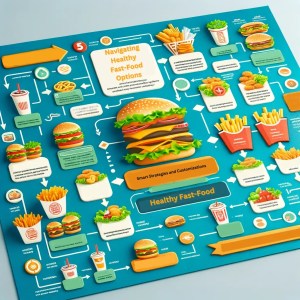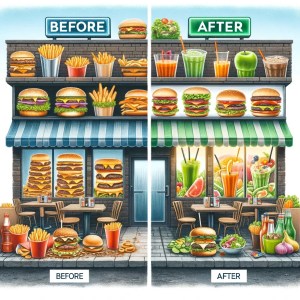- Introduction: Shifting Perceptions and the Quest for Healthier Fast-Food Choices
- Understanding Healthy Fast-Food:
- Latest Trends in Healthy Fast-Food:
- The Top Healthy Fast-Food Choices of 2024:
- Top Ten Healthy Fast Food Restaurant Choices
- Making Smart Choices: Making Fast-Food Healthier
- Pitfalls to Avoid
- Conclusion to Healthy Fast-Food in 2024
Introduction: Shifting Perceptions and the Quest for Healthier Fast-Food Choices

Shifting Perceptions: The Rise of Healthy Fast-Food
The fast-food industry, traditionally synonymous with unhealthy, fat-laden options, is undergoing a transformative shift. A new era of healthy fast-food is rising, driven by changing consumer preferences and a growing emphasis on health and wellness. Millennials and Gen Z consumers, in particular, are spearheading this change, showing a marked preference for healthier, environmentally conscious meal options. The global pandemic has further accelerated this trend, with a renewed focus on health-conscious eating habits. Fast food chains are responding to this demand by diversifying their menus to include healthier options like plant-based burgers, salads, grilled meats, and fish. This evolution signifies a departure from the fast-food industry’s historical image and demonstrates its adaptability to consumer demands for healthier, more nutritious choices.
The Modern Diner’s Quest for Healthier Fast-Food Choices
Today’s fast-food consumer is vastly different from those of previous decades. No longer satisfied with just convenience and taste, modern diners seek out fast food options that align with their health goals and lifestyle choices. This shift in consumer preferences is evident in the increasing popularity of healthier menu items, the demand for customization, and the use of technology to facilitate convenient, health-conscious dining experiences. Younger generations are particularly influential in this shift, valuing meals that cater to specific dietary needs and preferences. Customizable options, such as build-your-own-burger stations and personalized salads, have become essential offerings for fast-food establishments looking to attract health-conscious consumers. Additionally, the rise of online and mobile ordering platforms has made it easier for customers to access healthier fast-food options conveniently. This trend towards healthier eating is not a fleeting fad but a sustained movement, indicating a profound and lasting change in the fast food industry.
In summary, the fast-food industry is adapting to the evolving demands of a health-conscious consumer base. The traditional perception of fast-food as an unhealthy choice is being challenged by the introduction of nutritious, high-quality menu options and innovative service models. This transformation reflects a broader societal shift towards wellness and sustainable living, firmly placing healthy fast-food at the forefront of modern dietary trends.
Understanding Healthy Fast-Food:

Defining “Healthy” in the Fast-Food Context
The concept of “healthy” in fast-food has evolved beyond just calorie counts. A healthier fast-food option is one that balances nutrition while minimizing elements detrimental to health. Key attributes include:
- Lower Fat, Higher Protein and Fiber: Opt for foods that are lower in fat but higher in protein and fiber. This means prioritizing whole grains and high-quality protein sources while avoiding trans fats.
- Moderated Sodium Intake: Given the cardiovascular risks associated with high sodium intake, it’s crucial to manage sodium levels. While challenging in fast-food, this can be partially addressed by making specific requests, like cooking burgers without added salt.
- Portion Control: Many fast-food servings are significantly larger than dietary recommendations. Opting for the smallest available size and choosing children’s menu items can help manage portion sizes effectively.
- Lean Meats Over Fried Options: Grilled or roasted lean meats, such as skinless chicken, turkey, lean ham, or roast beef, are preferable to fried or breaded items, which are higher in calories and unhealthy fats.
Key Nutrients to Look for in Fast-Food
- Protein and Fiber: High-quality protein and fiber are essential for a balanced diet. They contribute to satiety and have numerous health benefits.
- Whole Grains: Whole grains are richer in nutrients and fiber compared to their refined counterparts. Opting for whole-grain buns or bread can significantly enhance the nutritional value of a fast food meal.
- Beware of Misleading Healthy Labels: Some dishes, like salads, may sound healthy but can be high in calories, unhealthy fats, and sodium, especially with certain dressings and toppings.
- Smart Choices in Condiments and Beverages: Selecting low-calorie dressings and zero-calorie beverages like water or unsweetened tea can significantly reduce the calorie count of a meal.
- Healthy Sides: Instead of traditional sides like fries or onion rings, consider healthier options such as side salads, baked potatoes, fresh fruit cups, or apple slices.
In summary, understanding and choosing healthy fast-food involves more than avoiding obvious calorie traps. It’s about making informed choices that include high-quality proteins, fiber, and whole grains, while being mindful of portion sizes, sodium content, and hidden calories in dressings, sides, and beverages. This approach helps align fast food choices with broader nutritional goals.
Latest Trends in Healthy Fast-Food:

Embracing Plant-Based and Grilled Options
The fast-food industry is witnessing a significant shift towards healthier choices. As customers increasingly seek nutritious alternatives, fast food restaurants are introducing a variety of healthier menu items such as salads, wraps, and grilled meats. This trend, emphasizing plant-based and grilled options, is expected to continue in 2024 as consumers prioritize health and wellness in their dietary choices. The inclusion of these items reflects a broader commitment to providing more balanced, health-conscious meals in fast food restaurants.
The Customization Revolution in Fast-Food
Customization has become a hallmark of the modern fast-food experience. Customers now have the flexibility to tailor their meals to suit individual preferences, choosing from a wide array of toppings, sauces, and ingredients. This trend enhances the dining experience by allowing for personalization and is expected to grow in popularity in 2024. Fast food establishments are adapting to this demand, recognizing that a one-size-fits-all approach no longer suffices in catering to the diverse tastes and dietary needs of today’s consumers.
Technology’s Role: Online Ordering for Health-Conscious Consumers
Digital transformation is reshaping the fast-food industry, with online ordering platforms, mobile payments, and loyalty programs becoming increasingly prevalent. These technological advancements enable fast food restaurants to streamline operations and improve customer experience, particularly catering to health-conscious consumers who appreciate the convenience and ease of accessing nutritious options remotely. The rise of digital platforms signifies a significant shift in how consumers interact with fast food establishments, prioritizing efficiency and accessibility.

Eco-Friendly Packaging: A New Dimension of Healthy Eating
Sustainability concerns are influencing the fast-food industry, with an emphasis on eco-friendly practices to reduce environmental impact. This includes the adoption of biodegradable packaging, sourcing ingredients locally, and promoting recycling programs. By incorporating these practices, fast food restaurants not only address environmental concerns but also appeal to eco-conscious consumers. This trend towards sustainability is a crucial aspect of the industry’s evolution, aligning with the growing global emphasis on environmental responsibility.
Premium Ingredients: The Push for Quality
The fast-food industry is experiencing a shift towards premiumization, with restaurants introducing high-quality, often organic ingredients into their menus. This trend caters to a growing segment of consumers willing to pay more for meals made with superior ingredients like organic produce and grass-fed beef. By offering premium options, fast food chains are differentiating themselves from competitors and meeting the increasing demand for healthier, more nutritious fast-food options.
Global Flavors: Expanding Palate Preferences
The exploration of global flavors is a prominent trend, reflecting a growing interest in diverse tastes and culinary traditions. Consumers are increasingly seeking out traditional heritage foods and ingredients from around the world, driven by a desire for cultural connections and new culinary experiences. This trend is particularly evident in the fast-food industry, where an expanding variety of global cuisines and dishes are being introduced, catering to a more adventurous and globally conscious consumer base.
These trends collectively point towards a more health-conscious, diverse, and environmentally responsible fast-food industry in 2024. The integration of healthier options, customizable meals, technological advancements, sustainable practices, premium ingredients, and global flavors are redefining the fast-food landscape, aligning it more closely with contemporary consumer preferences and global food trends.
The Top Healthy Fast-Food Choices of 2024:

Salads: Beyond the Greens
- Chick-fil-A Market Salad: Offers a blend of grilled chicken, mixed greens, berries, and crunchy toppings like granola and almonds. It’s a nutrient-rich option with a balance of protein, fiber, and antioxidants.
- Sweetgreen Super Green Goddess: A satisfying plant-based option packed with chickpeas, lentils, and a variety of greens. It caters to both vegetarians and meat-eaters, with an emphasis on fresh, wholesome ingredients.
Smoothies: Nutrient-Packed Beverages
While specific smoothie options for 2024 are not detailed in the current research, the trend towards smoothies as a healthy fast-food choice is evident. Consumers are looking for beverages that are rich in vitamins, minerals, and other nutrients, often made with fresh fruits, vegetables, and protein sources.
Breakfast Options: Starting the Day Right
- McDonald’s Egg McMuffin: A balanced breakfast option with protein-rich egg and a moderate calorie count, making it a suitable choice for those looking to maintain a healthy diet.
- Subway 6-inch Turkey Sub: This sandwich offers a customizable, low-calorie breakfast choice with the option to include whole grains and lean protein, contributing to a satisfying and nutritious start to the day.
Grilled and Unbattered Choices: Savoring the Protein
- Chick-fil-A Grilled Chicken Sandwich: A lower-calorie option that doesn’t compromise on flavor, offering a good source of protein and the option to pair with healthy sides like fruit cups or salads.
- Arby’s Classic Roast Beef Sandwich: Provides a lean protein option with balanced calories, ensuring a filling meal without excessive fat or calories.
Sandwiches and Bowls: Balancing Nutrition and Flavor
- CAVA’s Greens and Grains Bowl: Allows customization with a variety of greens, lean proteins, and healthy fats, providing a nutritionally dense meal that’s both filling and flavorful.
- Chipotle Chicken Bowl: A popular choice for those seeking a balance of protein, fiber, and healthy carbs, with options to customize ingredients like brown rice, beans, and salsa.
Mexican-Inspired Dishes: A Healthy Twist
- Taco Bell Chicken Power Bowl: A well-rounded option that includes fiber, protein, and a moderate calorie count, offering a satisfying meal that’s both healthy and flavorful.
These selections highlight the evolving landscape of healthy fast-food in 2024, focusing on balanced nutrition, customizable options, and diverse flavors that cater to various dietary preferences and health goals.
Top Ten Healthy Fast Food Restaurant Choices
Navigating the world of fast food while maintaining a health-conscious diet can be challenging. Yet, a growing number of popular chains across the United States are catering to this need, offering nutritious options that don’t skimp on flavor. Whether you’re making a quick stop off the highway or seeking a meal that aligns with your dietary preferences, these ten fast food restaurants, each with over 400 locations, provide a range of healthy choices.
- Burger King:
- Catering to vegetarians, Burger King offers the Impossible burger. For a healthier twist, opt for lettuce wraps instead of buns and skip high-calorie toppings like mayonnaise and cheese. Opt for a side salad instead of fries. Be mindful of portion sizes and avoid sugary drinks.
- CAVA:
- This Mediterranean-inspired fast-casual restaurant offers customizable hot bowls, salads, and pita wraps. CAVA’s menu features unique items like roasted eggplant, falafel, grilled meats, and RightRice—a blend with higher protein and fiber content than regular white rice. Pick a base of greens or grains, add lots of vegetables, and a lean protein source like grilled chicken or falafel. Be mindful of the amount of dressing and high-calorie toppings.
- Chipotle:
- At Chipotle, you have the power to craft your meal. Opt for salads or burrito bowls rich in protein and fiber. Limit high-calorie toppings like cheese, sour cream, and guacamole.
- Noodles & Company:
- For noodle lovers, Noodles & Company presents a healthy twist with vegetable noodle bowls, various sauces, and protein options like tofu, shrimp, and grilled chicken. They also offer zucchini noodles and high-protein LEANguini as alternatives to regular pasta. Choose zucchini noodles or the high-protein LEANguini. Add a variety of vegetables and a lean protein source. Avoid creamy and high-fat sauces.
- Panda Express:
- Panda’s “Wok Smart” menu guarantees dishes with at least 8 grams of protein and under 300 calories. Options include steamed brown rice, super greens, tofu dishes, and grilled seafood or chicken. Opt for “Wok Smart” menu items, which are lower in calories. Choose steamed brown rice or super greens as a side. Be mindful of the sauces, as they can add a lot of sugar and calories. Note for gluten-sensitive diners: except for the steamed rice, all items contain gluten.
- Panera Bread:
- Known for its inviting ambiance, Panera Bread also offers a health-friendly menu. Their dishes range from protein-rich salads to ‘pick two’ combinations of soups, salads, and sandwiches. Opt for whole-grain bread and swap chips for an apple to make your meal even healthier. Opt for salads with lean proteins. Avoid high-calorie dressings and creamy soups. Consider the “You Pick Two” option for smaller, balanced portions.
- Sweetgreen:
- Though not a typical freeway find, Sweetgreen’s presence in 21 states makes it a notable choice for health enthusiasts. They specialize in warm bowls and salads with bases like wild rice or quinoa and a variety of greens, topped with nuts, seeds, beans, vegetables, proteins, and a selection of dressings.
- Wendy’s:
- Wendy’s stands out among traditional fast-food chains with its salad offerings, including vegetarian-friendly options. They also serve grilled chicken wraps, baked potatoes, and apple bites, providing healthier sides than the usual fast-food fare. Select a salad but be cautious of high-calorie dressings and toppings like croutons and cheese. Opt for grilled chicken items and avoid fried foods and creamy condiments.
- Smoothie King:
- Ideal for a quick, refreshing meal, Smoothie King, along with similar brands, offers smoothies with a range of fruits, vegetables, dairy or plant-based milks, and supplements like protein powders. However, keep an eye on the calorie and sugar content, especially in larger sizes.
- Starbucks:
- Beyond coffee, Starbucks has expanded its menu to include wholesome choices. Health-conscious patrons can enjoy steel-cut oatmeal, egg white wraps, protein-packed boxes with fruits, eggs, whole-grain crackers, and nut butter, and egg bites. Choose low-calorie options like egg white bites, steel-cut oatmeal, and protein boxes. Avoid high-sugar drinks and pastries. Opt for black coffee, tea, or lattes with non-fat or plant-based milk.
These restaurants exemplify the shift towards healthier fast food options, making it easier to find nourishing meals on the go. Whether it’s a quick breakfast, a customizable lunch bowl, or a protein-packed dinner, these chains offer a range of choices for those mindful of their dietary habits.
Making Smart Choices: Making Fast-Food Healthier

Portion Control and Balanced Meals
- Calorie Management: Aim for meals with 500 calories or less. Most people underestimate their calorie intake, so it’s important to check the nutritional information provided by fast-food chains.
- Balanced Nutrition: Choose items lower in fat and higher in protein and fiber, such as whole grains and quality proteins. Also, avoid trans fats and opt for foods low in saturated fats.
Navigating Menus: Identifying Healthier Options
- Mindful Selection: Watch out for menu descriptions like deep-fried, pan-fried, breaded, or creamy, as these tend to be high in calories, unhealthy fats, and sodium. Opt for grilled or roasted lean meats instead.
- Avoid Hidden Pitfalls: Be cautious with seemingly healthy options, as some, like salads, can be high in calories due to high-fat dressings and fried toppings.
Customization Tips: Building a Better Meal
- Special Requests: Don’t hesitate to special order. Requesting dressings or sauces on the side, choosing a wheat bun, or whole-grain bread for sandwiches can make a significant difference in nutritional value.
- Control Condiments and Sides: Limit high-calorie condiments and dressings and opt for zero-calorie beverages. Choose healthier sides like salads with light dressing, baked potatoes, or fresh fruits instead of fries or chips.
- Salad Smart Choices: Select salads with low-fat dressings and grilled protein. Avoid high-calorie toppings like bacon bits, cheese, and croutons, and steer clear of taco salads with deep-fried shells.
Making smart choices in fast food involves being proactive about what and how you order. This includes being aware of portion sizes, opting for balanced nutritional profiles in meals, and customizing your order to align with health goals. By being vigilant about these aspects, you can enjoy fast food while still maintaining a healthy diet.
Pitfalls to Avoid

Hidden Calories in Dressings and Condiments
- Salad Dressings: They can significantly increase the calorie and sodium content of salads. Creamy dressings, in particular, can be high in calories. For instance, a single serving of Chick-fil-A’s Avocado Lime Dressing adds 310 calories and 530 mg of sodium. Many people overuse dressings, assuming that the provided amount is one serving, which often isn’t the case.
The Deceptive Nature of “Healthy-Sounding” Dishes
- Salad Toppings: High-calorie toppings like cheese quesadillas, tortilla strips, and certain dressings can transform a salad into a high-calorie meal. For example, Chili’s Quesadilla Explosion Salad contains 1,400 calories, mainly from high calorie toppings.
- Excess of ‘Healthy’ Ingredients: Nutrient-rich ingredients like nuts, dried fruit, and avocado can cause the calorie count to skyrocket if used excessively. An example is a Chipotle salad, which can quickly become a high-calorie meal with the addition of several healthy ingredients.
Sides and Beverages: Making Wise Choices
- Side Items: Seemingly wholesome side items like soups or bread can significantly increase the overall calorie and sodium content of a meal. For instance, adding Panera’s Broccoli and Cheddar Side Soup to a salad increases calories and sodium considerably.
- Reward Mentality: Opting for additional treats like fries or desserts, often rationalized as a reward, can negate the health benefits of a chosen main dish. For example, adding small waffle fries from Chick-fil-A or a chocolate frosty from Wendy’s to a salad can considerably increase the meal’s calorie content.
Avoiding these pitfalls involves being vigilant about the ingredients and portions of dressings, condiments, side items, and additional treats. Reading nutritional information and making informed decisions can significantly help in maintaining the healthiness of fast-food meals.
Conclusion to Healthy Fast-Food in 2024

The Evolving Landscape of Fast-Food
The fast-food industry has undergone a remarkable transformation, aligning more closely with the health and dietary preferences of contemporary consumers. The rise of plant-based options, customizable meals, advanced technology, sustainable practices, and global flavors signifies a new era where fast food is no longer synonymous with unhealthy eating.
Embracing Change: How Healthy Fast-Food Is Becoming Mainstream
Healthy fast-food is steadily becoming mainstream, driven by consumer demand for more nutritious, environmentally responsible, and diverse dining options. This shift reflects a broader societal movement towards wellness and sustainability, with fast food chains adapting to offer balanced, health-conscious meals. As this trend continues to evolve, it underscores the industry’s capacity to innovate and respond to changing dietary needs, making healthy fast-food an integral part of the modern culinary landscape.

Join the conversation on our forum, Simply Sound Society, to share your experiences and insights about the evolving world of healthy fast-food! Whether you’re trying new menu items, exploring the latest trends, or have tips on making smarter choices, we’d love to hear from you. Connect with a community of like-minded individuals and let’s navigate the delicious journey of healthy eating together! Click here to join the forum now.
What’s your favorite healthy fast-food option, and how does it fit into your overall health goals? Share your top picks and any tips you have for making healthier choices while enjoying the convenience of fast food. We’re excited to hear your thoughts and experiences in the comments below!
Don’t Miss Out on These Other Great Posts:
- The Sesame Care Advantage: Revolutionizing Healthcare Access
- Healthcare Assistance for Low-Income Families in the U.S.
- Ultimate Guide to Assistance Programs in the U.S.: Federal, National, and State-Specific Support
- The Credit Pros: Enhancing Your Financial Journey
- Navigating an Impending Recession: 7 Strategies for Financial Stability
















Great Read –
Kind Regards Mel
Keto Recipes – https://ketodietrecipes.co.uk/
Thank you Mel! If you have any questions or concerns, please reach out to me [email protected]. Happy New Year!
Loved this post – heress my feedback –
Looking To Tone Up? Lose Extra lb’s Just By Changing What You Eat?
Download Over 50 Keto Recipes , Unleash The Flavours – http://ketodietrecipes.co.uk/